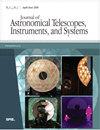科罗拉多紫外线过境实验:美国国家航空航天局第一颗紫外线天文学立方体卫星的任务开发历史和未来可能性
IF 3.1
3区 工程技术
Q2 ENGINEERING, AEROSPACE
Journal of Astronomical Telescopes Instruments and Systems
Pub Date : 2024-07-01
DOI:10.1117/1.jatis.10.3.030301
引用次数: 0
摘要
美国国家航空航天局(NASA)的首个专用系外行星光谱任务--科罗拉多紫外线凌日实验(CUTE)--用于寻找大气逸出的迹象,即组成气体离开行星大气层的过程。通过凌日光谱,可以探测到近距离行星周围由母星高水平紫外线(UV)辐射驱动的逸散迹象。CUTE 是一颗 6U 立方体卫星,由位于美国科罗拉多州博尔德的科罗拉多大学大气与空间物理实验室(LASP)开发和运行;它利用 208×84 毫米卡塞格伦望远镜馈电的紫外线增强带电耦合器件,在近紫外线(2479 至 3306 Å)范围内勘测近邻太阳系外行星,从而寻找这些逃逸迹象。CUTE于2017年通过美国国家航空航天局(NASA)ROSES提案获得资助,在其制造和测试计划的核心阶段被迫应对全球大流行,它证明了小型卫星按计划发射和执行具有挑战性的天文测量的能力。我们将重点介绍CUTE任务的科学目标、实施情况以及在成功交付科学计划的道路上所经历的磨难,同时讨论有关开发立方体卫星计划的经验教训,以及这些经验教训在未来CUTE式后续任务中的应用。本文章由计算机程序翻译,如有差异,请以英文原文为准。
Colorado Ultraviolet Transit Experiment: a mission development history and future possibilities from the National Aeronautics and Space Administration’s first ultraviolet astronomy CubeSat
The National Aeronautics and Space Administration’s (NASA) first dedicated exoplanetary spectroscopy mission, the Colorado Ultraviolet Transit Experiment (CUTE), is used to search for signatures of atmospheric escape, the process by which constituent gases depart a planetary atmosphere. Through transit spectroscopy, the signs of escape driven by the high level of ultraviolet (UV) radiation from their parent stars are detectable around close-in planets. CUTE is a 6U CubeSat developed and operated by the Laboratory for Atmospheric and Space Physics (LASP) of the University of Colorado in Boulder, Colorado, United States; it looks for these signs of escape by surveying close-in extrasolar planets in the near-UV (2479 to 3306 Å) with 208×84 mm Cassegrain telescope-fed, UV-enhanced charged coupled device. Funded through a NASA ROSES proposal in 2017 and forced to deal with a worldwide pandemic during the heart of its fabrication and test program, CUTE has demonstrated the capability of small satellites to launch on schedule and perform challenging astronomical measurements. We will highlight the CUTE mission’s science objectives, implementation, and tribulations on its road to delivering a successful science program while discussing lessons learned pertaining to the development of CubeSat programs and the application of those lessons for a CUTE-style follow-on mission in the future.
求助全文
通过发布文献求助,成功后即可免费获取论文全文。
去求助
来源期刊

Journal of Astronomical Telescopes Instruments and Systems
Engineering-Mechanical Engineering
CiteScore
4.40
自引率
13.00%
发文量
119
期刊介绍:
The Journal of Astronomical Telescopes, Instruments, and Systems publishes peer-reviewed papers reporting on original research in the development, testing, and application of telescopes, instrumentation, techniques, and systems for ground- and space-based astronomy.
 求助内容:
求助内容: 应助结果提醒方式:
应助结果提醒方式:


